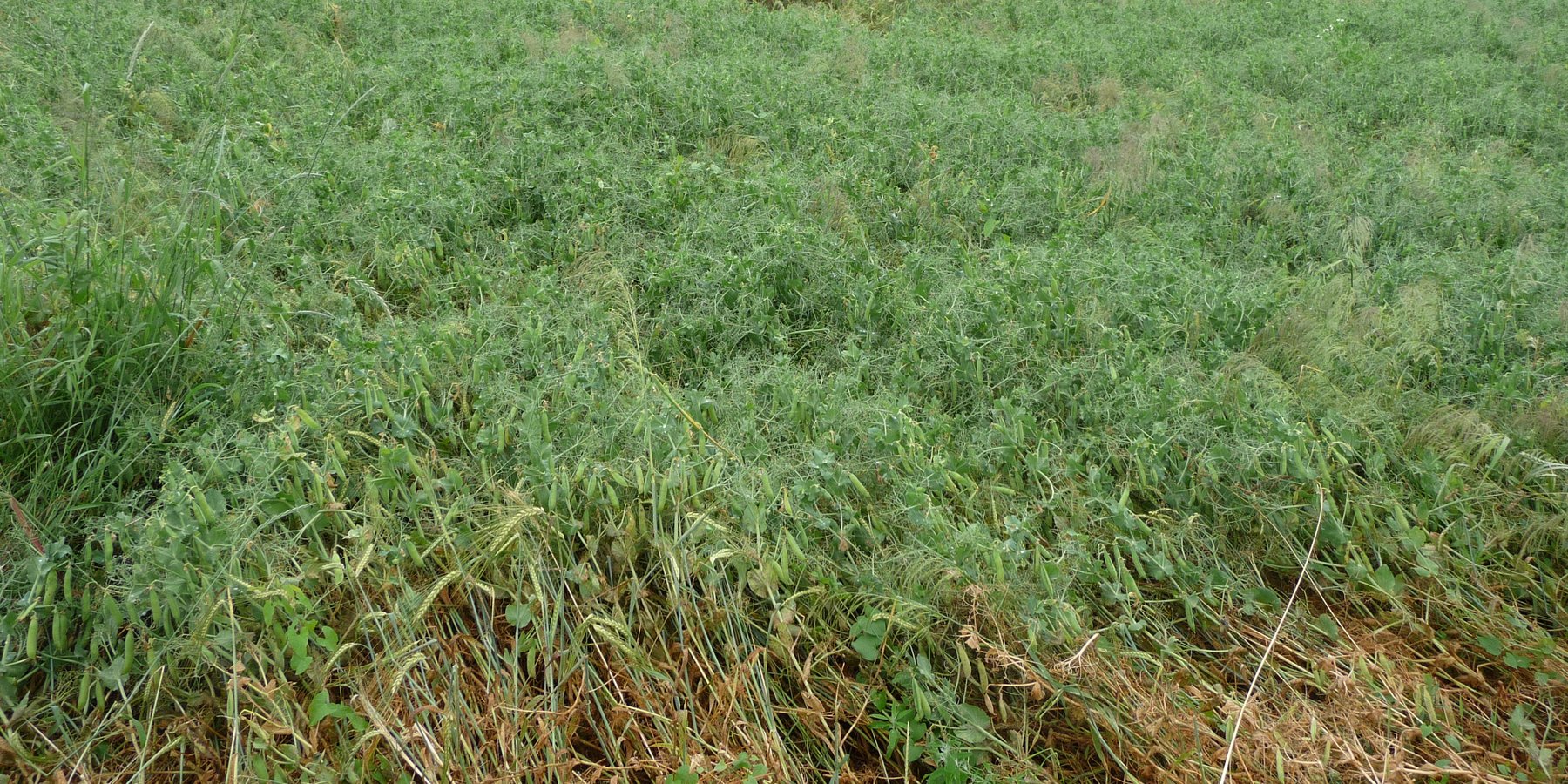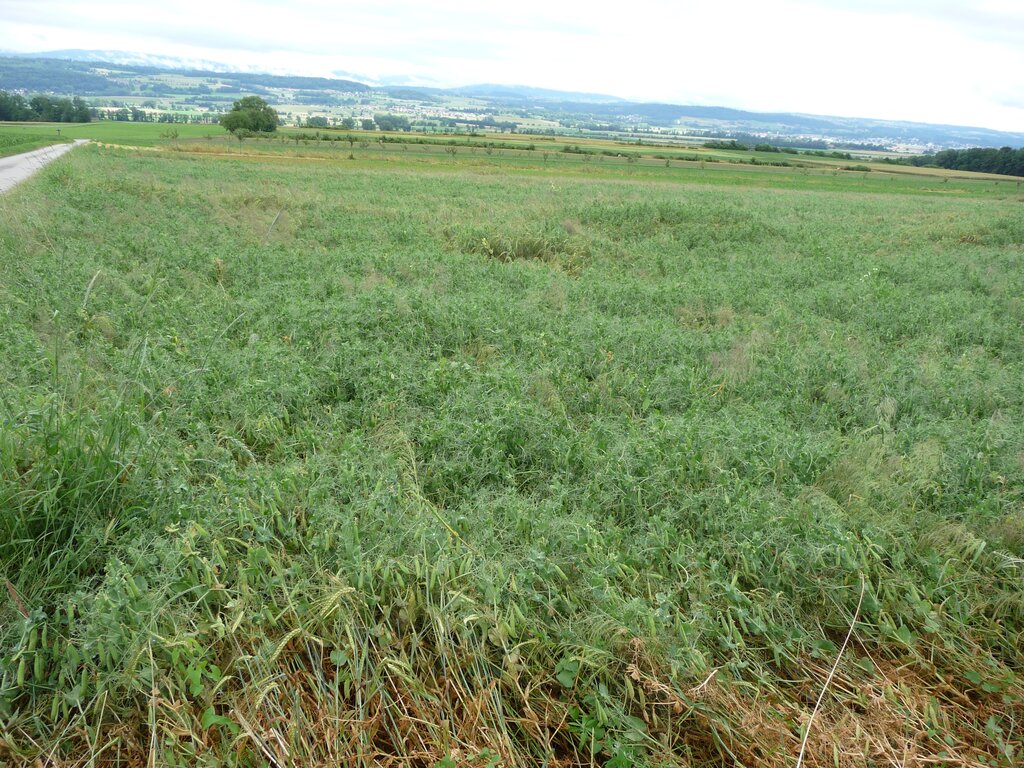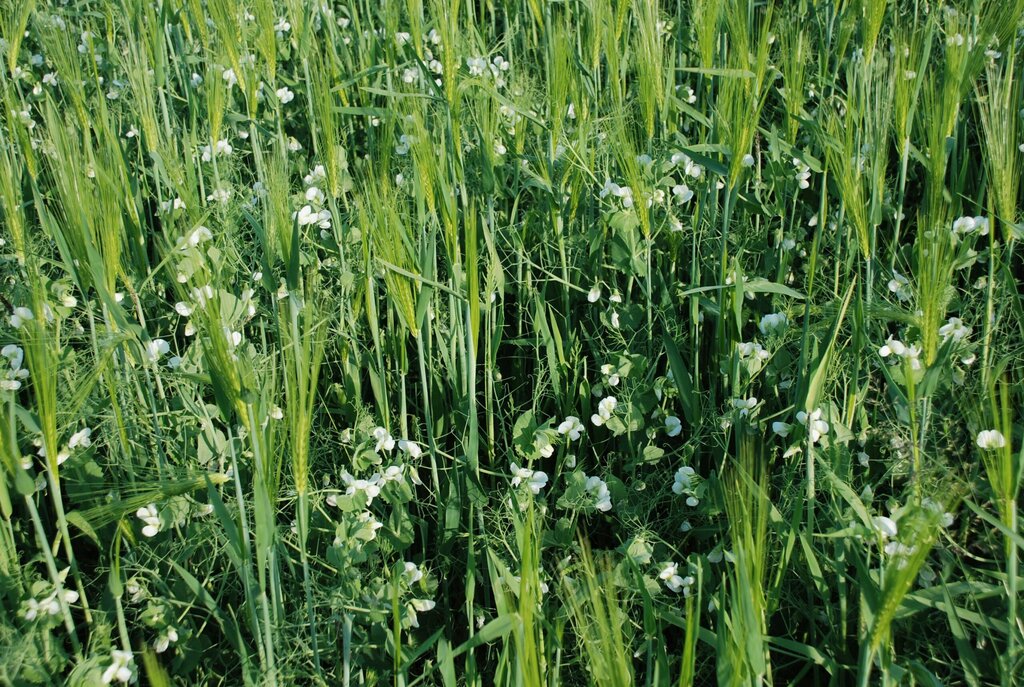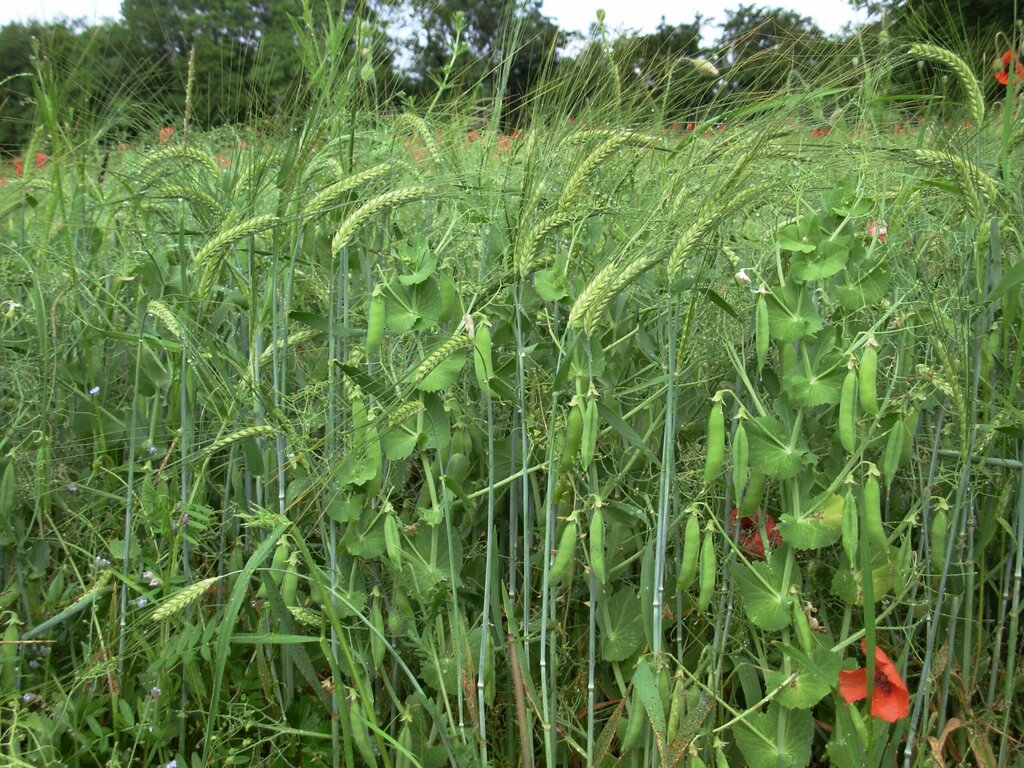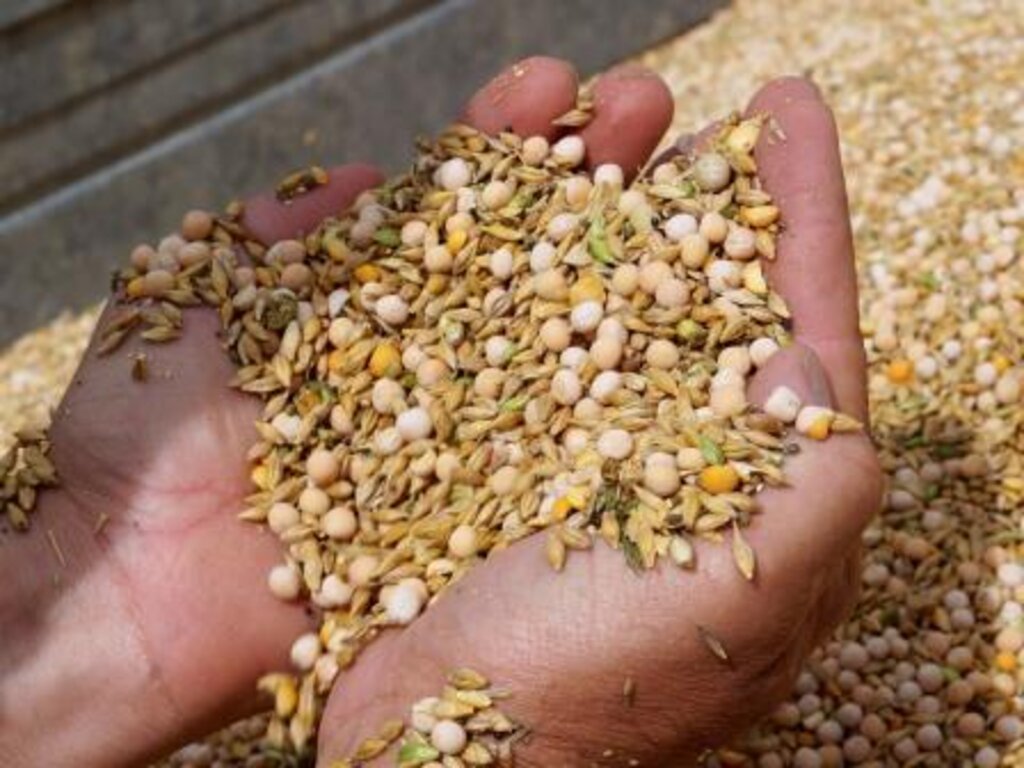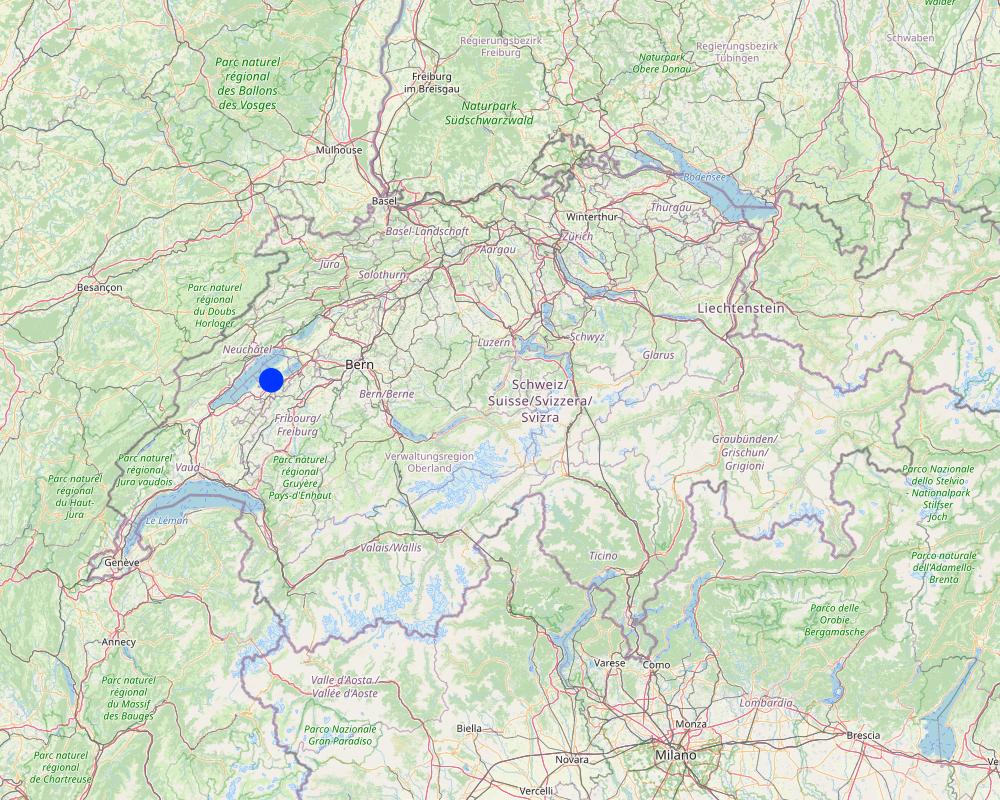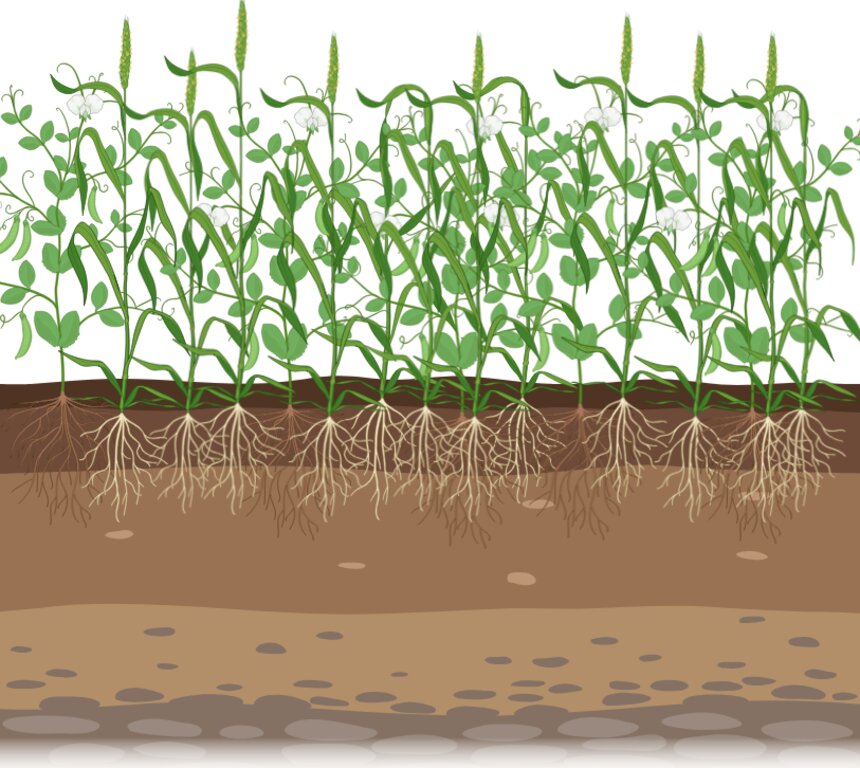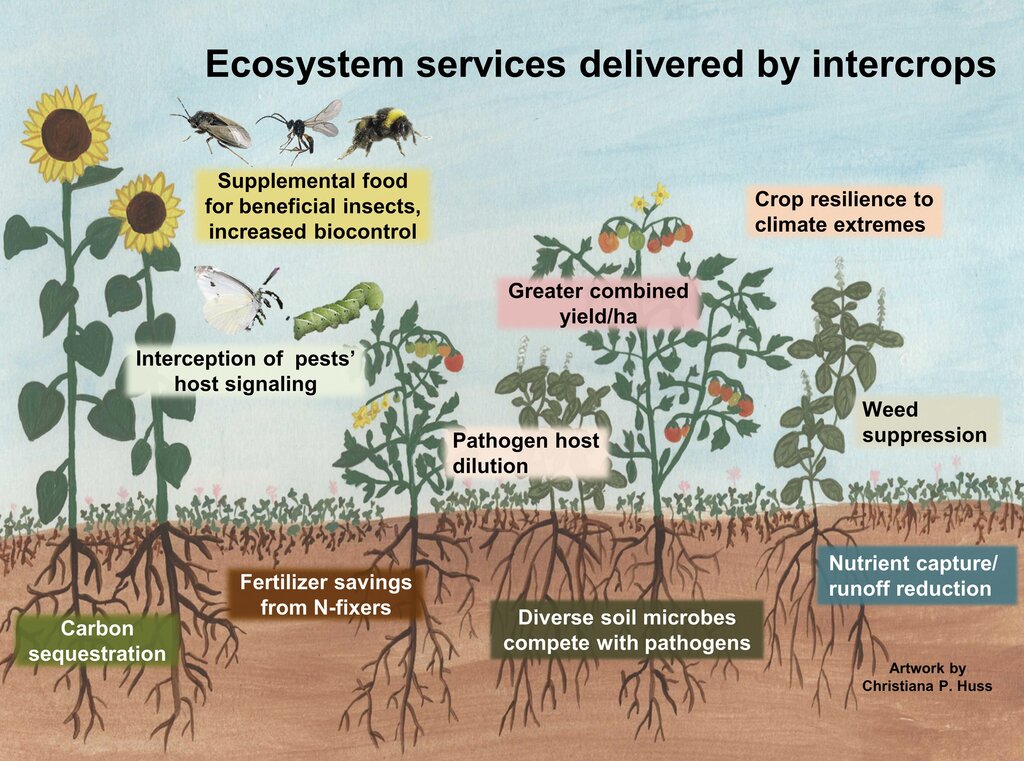Intercropping of grain legumes with cereals [Suíça]
- Criação:
- Atualização:
- Compilador/a: Basile Brunner
- Editores: Maria Eliza Turek, Tatenda Lemann, Joana Eichenberger
- Revisores: William Critchley, Joana Eichenberger
Mischkultur von Körnerleguminosen und Getreide
technologies_6235 - Suíça
Veja as seções
Expandir tudo Recolher tudo1. Informação geral
1.2 Detalhes do contato das pessoas capacitadas e instituições envolvidas na avaliação e documentação da tecnologia
Pessoa(s) capacitada(s)
usuário de terra:
Quillet Lucien
Suíça
Especialista em GST:
Klaiss Matthias
Research Institute of Organic Agriculture FiBL
Suíça
Nome do projeto que facilitou a documentação/avaliação da Tecnologia (se relevante)
OPtimal strategies to retAIN and re-use water and nutrients in small agricultural catchments across different soil-climatic regions in Europe (OPTAIN)Nome da(s) instituição(ões) que facilitou(ram) a documentação/ avaliação da Tecnologia (se relevante)
CDE Centre for Development and Environment (CDE Centre for Development and Environment) - Suíça1.3 Condições em relação ao uso da informação documentada através de WOCAT
O/a compilador/a e a(s) pessoa(s) capacitada(s) aceitam as condições relativas ao uso de dados documentados através da WOCAT:
Sim
1.4 Declaração de sustentabilidade da tecnologia descrita
A tecnologia descrita aqui é problemática em relação a degradação da terra de forma que não pode ser declarada uma tecnologia de gestão sustentável de terra?
Não
2. Descrição da tecnologia de GST
2.1 Descrição curta da tecnologia
Definição da tecnologia:
Intercropping of grain legumes with cereals is a sustainable agricultural practice in Swiss farming. This involves growing grain legumes (such as peas or beans) alongside cereal crops (like barley or wheat) in the same field, reducing crop failure or yield risk, stabilising the grain legumes, promoting biodiversity and enhancing overall crop yield.
2.2 Descrição detalhada da tecnologia
Descrição:
Intercropping of grain legumes with cereals is practised in the Broye catchment area, which covers the cantons of Vaud and Fribourg in Switzerland. The area is characterised by mixed dairy and arable production in the hills and predominantly arable production in the lowlands. The area has an average annual rainfall of 865 mm, an average temperature of 9.6°C and significant agricultural activity relies on irrigation from local rivers.
Intercropping is the simultaneous cultivation of two or more crops in the same field. In this case, grain legumes (such as peas, lupins or faba beans) are grown alongside cereals (such as barley, oats or wheat). The crops are sown together in a pre-prepared mixture, usually at a ratio of 65% legumes to 35% cereals by weight, compared to the standard weight sown in monoculture (100%). The seeds are fully mixed and sown in the same row. Crops are grown over the winter and harvested simultaneously in the spring, which requires compatible combinations whose breeding is continuously optimised for simultaneous ripening. The standard practice in Switzerland is to use a cereal plus a legume.
The main purpose of intercropping grain legumes with cereals is to increase ecological resilience and improve soil fertility. Including legumes in rotations significantly improves soil nitrogen levels, reducing the need for synthetic fertilisers. Intercropping also increases water infiltration, reduces runoff and increases biodiversity. The increase in biodiversity is small in terms of the overall biodiversity of agricultural land (e.g. soil micro-organisms, pollinators). The number of crops grown remains relatively constant. The practice aims to produce higher yields on a given piece of land by using resources that would otherwise not be used by a single crop. The overall yield is higher, although land equivalent ratios (LER) were not measured in this study. However, a cited paper (Chapagain & Riseman, 2014) shows that intercropping barley with peas can increase land productivity by 12-32% compared to monoculture plots, with a 2:1 arrangement producing the highest total land outputs and LER values.
Establishing and maintaining intercropping requires several key activities and inputs: (1) Use of tractors and seed drills for planting and harvesting intercrops. (2) Regular weeding, especially in fields with crops such as soy. (3) Episodic irrigation with water from local irrigation syndicates. (4) Minimal use of fertiliser and homemade manure to maintain soil health.
Intercropping has many benefits: (1) Increases biodiversity, improves soil fertility and increases water infiltration. (2) Reduces the need for synthetic fertilisers, making it economically viable for farmers. (3) Improves drought resistance and reduces the risk of crop failure. (4) Contributes to better water management and resilience to climate change. (5) Surface erosion is reduced by the greater cover of mixed crops (leaf area index).
Farmers appreciate the effectiveness of intercropping in achieving yields similar to monocultures, while adding the benefits of cereals. They also value the reduced need for synthetic fertilisers and improved soil health. However, challenges include seed selection and segregation, particularly for crops such as wheat and faba beans, and weed management in certain fields.
2.3 Fotos da tecnologia
2.5 País/região/locais onde a tecnologia foi aplicada e que estão cobertos nesta avaliação
País:
Suíça
Região/Estado/Província:
Missy / Vaud / Switzerland
Especifique a difusão da tecnologia:
- Uniformemente difundida numa área
O(s) local(is) tecnológico(s) está(ão) localizado(s) em uma área permanentemente protegida?
Não
Map
×2.6 Data da implementação
Caso o ano exato seja desconhecido, indique a data aproximada:
- 10-50 anos atrás
2.7 Introdução da tecnologia
Especifique como a tecnologia foi introduzida:
- durante experiências/ pesquisa
Comentários (tipos de projeto, etc.):
Only one farmer was interviewed who practices mixed cropping on 4 ha.
3. Classificação da tecnologia de GST
3.1 Principal/principais finalidade(s) da tecnologia
- Melhora a produção
- Adaptar a mudanças climáticas/extremos e seus impactos
- Criar impacto econômico benéfico
3.2 Tipo(s) atualizado(s) de uso da terra onde a tecnologia foi aplicada
Uso do solo misturado dentro da mesma unidade de terra:
Não

Terra de cultivo
- Cultura anual
Cultivo anual - Especificar culturas:
- cereais - cevada
- cereais - aveia
- Legumes e leguminosas - outras
- legumes e leguminosas - ervilhas
- Lupine (legume)
Número de estações de cultivo por ano:
- 1
O cultivo entre culturas é praticado?
Sim
Em caso afirmativo, especifique quais são as culturas intercultivadas:
Pea - barley, and lupine - oat
O rodízio de culturas é praticado?
Sim
Caso afirmativo, especifique:
field rotation is as follows: cereals, legumes or maize, cereals, legumes or maize ... And every six years, two successive legumes/maize
3.3 O uso do solo mudou devido à implementação da Tecnologia?
O uso do solo mudou devido à implementação da Tecnologia?
- Não (Continuar com a pergunta 3.4)
3.4 Abastecimento de água
Abastecimento de água para a terra na qual a tecnologia é aplicada:
- Misto de precipitação natural-irrigado
Comentários:
All the plots on the farm are connected to a stream. The farmer tries to irrigate as little as possible, as it's time consuming and expensive. As there was enough rain this year, there was no need to irrigate the fields.
3.5 Grupo de GST ao qual pertence a tecnologia
- Solo/cobertura vegetal melhorada
- Gestão integrada de fertilidade do solo
- variedades vegetal/raças de animais melhoradas
3.6 Medidas de GST contendo a tecnologia

Medidas agronômicas
- A1: cobertura vegetal/do solo
- A2: Matéria orgânica/fertilidade do solo
- A5: Gestão de sementes, variedades melhoradas
3.7 Principais tipos de degradação da terra abordados pela tecnologia

Erosão do solo pela água
- Wt: Perda do solo superficial/erosão de superfície
3.8 Redução, prevenção ou recuperação da degradação do solo
Especifique o objetivo da tecnologia em relação a degradação da terra:
- Prevenir degradação do solo
4. Especificações técnicas, implementação de atividades, entradas e custos
4.1 Desenho técnico da tecnologia
Especificações técnicas (relacionada ao desenho técnico):
The illustration shows a field where peas and barley are grown together in a mixed cropping system. The plants with rounded leaves and tendrils are peas, while the taller plants with linear leaves are barley. The interviewed farmer typically grows these crops on an area of two to three hectares. The mixed crops are at an advanced stage of growth, several weeks before harvest, with both pea and barley producing seed. The rooting depth of the pea plants can reach up to 110 centimetres, while the barley plants can extend their roots up to 150 centimetres under optimal conditions.
These plants grow on brown soil composed of three main horizons. Horizon A is usually brownish in colour and extends to a depth of over 20 cm. It is rich in organic matter and mineral particles, making it biologically active with many soil organisms and plant roots. The B horizon is lighter in colour and typically extends from about 20 cm to 150 cm deep. It contains minerals leached from the A horizon and shows signs of weathering, with a more defined structure due to the accumulation of minerals and organic matter from the upper layers. The C horizon, or parent material, lies below the B horizon and extends beyond 150 cm. It consists of partially disintegrated and weathered parent material, is typically lighter in colour than the B horizon and has minimal biological activity compared to the upper layers.
Autor:
Basile Brunner (UniBE)
Data:
15/08/2024
Especificações técnicas (relacionada ao desenho técnico):
llustration of benefits of intercropping for crop resilience and crop yields, management of soils, weeds, pests, and pathogens, along with environmental benefits of carbon sequestration and reduction of fossil fuel inputs.
Autor:
Christiana Huss
Data:
22/04/2022
4.2 Informação geral em relação ao cálculo de entradas e custos
Especifique como custos e entradas foram calculados:
- por área de tecnologia
Indique o tamanho e a unidade de área:
ha
Outro/moeda nacional (especifique):
CHF
Se for relevante, indique a taxa de câmbio do USD para moeda local (por exemplo, 1 USD = 79,9 Real): 1 USD =:
1,13
Indique a média salarial da mão-de-obra contratada por dia:
240 CHF
4.5 Atividades recorrentes/manutenção
| Atividade | Periodicidade/frequência | |
|---|---|---|
| 1. | Mixing seeds: For single tank seeders, mix seeds at a ratio of 80% peas and 40% barley. For multi-tank seeders, apply seeds of mixture partners separately. | Before sowing, typically in late summer. |
| 2. | Sowing: Use a row spacing of 12 cm, and place seeds at a depth of 3 to 4 cm. | late october |
| 3. | Assess the mix’s condition after winter. | Spring, depending on winter severity. |
| 4. | Weed Control: Generally not needed due to the competitive nature of the mixed crop. If high weed pressure: Consider harrowing once (2-3 hours per hectare for weeding). | Spring, depending on winter severity. |
| 5. | Harvesting: Adjust harvester sieves for peas. Open threshing concave and hulling bars wide. Maintain low drum rotation. Monitor for grain loss regularly. Adjust Vario-table to an aggressive cutting angle. | Summer. |
Comentários:
Maintenance activities for a mixed intercropping culture of winter peas/barley.
Cultivate the mixed crop only every seventh year in crop rotation. Avoid growing lupins, vetches, lucerne, or pure stands of red clover in between. No nitrogen fertilisation. Irrigation only in very dry years.
4.6 Custos e entradas necessárias pata a manutenção/atividades recorrentes (por ano)
| Especifique a entrada | Unidade | Quantidade | Custos por unidade | Custos totais por entrada | % dos custos arcados pelos usuários da terra | |
|---|---|---|---|---|---|---|
| Mão-de-obra | Ploughing | person-days | 1,0 | 200,0 | 200,0 | 100,0 |
| Mão-de-obra | Sowing the Mixture | person-days | 1,0 | 200,0 | 200,0 | 100,0 |
| Mão-de-obra | Weeding | person-hours | 3,0 | 23,0 | 69,0 | 100,0 |
| Equipamento | seeder | piece | 1,0 | 10000,0 | 10000,0 | 100,0 |
| Equipamento | tractor | piece | 1,0 | 30000,0 | 30000,0 | 100,0 |
| Equipamento | harvester | piece | 1,0 | 15000,0 | 15000,0 | 100,0 |
| Equipamento | plough | piece | 1,0 | 15000,0 | 15000,0 | 100,0 |
| Material vegetal | Seed mixture protein peas / barley mixture (autumn sowing) organic | kg/ha | 200,0 | 6,0 | 1200,0 | 100,0 |
| Custos totais para a manutenção da tecnologia | 71669,0 | |||||
| Custos totais de manutenção da Tecnologia em USD | 63423,89 | |||||
Comentários:
Normal machinery (tractor, seeder, harvester) can be used. In many cases it is already available on the farm.
Weed control is usually not needed. If there is high weed pressure, harrow or hoe it once.
No nitrogen fertilising for the crop. Irrigation would only be needed in an extremely dry year.
In order to avoid legume fatigue in the soil, only cultivate the mixed crop every seventh year. Also do not grow lupins, vetches, Lucerne or pure stands of red clover in between.
4.7 Fatores mais importantes que afetam os custos
Descreva os fatores mais determinantes que afetam os custos:
No exceptional investments are needed as existing machines are used.
The cost of seeds and the seed sorting costs by the mills.
Time and labour required for weeding, which can vary based on crop type.
The demand and price for the crops grown. E.g. soy having higher demand and price compared to peas.
5. Ambiente natural e humano
5.1 Clima
Precipitação pluviométrica anual
- <250 mm
- 251-500 mm
- 501-750 mm
- 751-1.000 mm
- 1.001-1.500 mm
- 1.501-2.000 mm
- 2.001-3.000 mm
- 3.001-4.000 mm
- > 4.000 mm
Especifique a média pluviométrica anual em mm (se conhecida):
865,00
Indique o nome da estação meteorológica de referência considerada:
Payerne
Zona agroclimática
- Subúmido
average maximum temperature 14.2°C, average minimum temperature 5.1°C
5.2 Topografia
Declividade média:
- Plano (0-2%)
- Suave ondulado (3-5%)
- Ondulado (6-10%)
- Moderadamente ondulado (11-15%)
- Forte ondulado (16-30%)
- Montanhoso (31-60%)
- Escarpado (>60%)
Formas de relevo:
- Planalto/planície
- Cumes
- Encosta de serra
- Encosta de morro
- Sopés
- Fundos de vale
Zona de altitude:
- 0-100 m s.n.m.
- 101-500 m s.n.m.
- 501-1.000 m s.n.m.
- 1.001-1.500 m s.n.m.
- 1.501-2.000 m s.n.m.
- 2.001-2.500 m s.n.m.
- 2.501-3.000 m s.n.m.
- 3.001-4.000 m s.n.m.
- > 4.000 m s.n.m.
Indique se a tecnologia é aplicada especificamente em:
- Não relevante
5.3 Solos
Profundidade do solo em média:
- Muito raso (0-20 cm)
- Raso (21-50 cm)
- Moderadamente profundo (51-80 cm)
- Profundo (81-120 cm)
- Muito profundo (>120 cm)
Textura do solo (solo superficial):
- Fino/pesado (argila)
Textura do solo (>20 cm abaixo da superfície):
- Fino/pesado (argila)
Matéria orgânica do solo superficial:
- Médio (1-3%)
5.4 Disponibilidade e qualidade de água
Lençol freático:
< 5 m
Disponibilidade de água de superfície:
Bom
Qualidade da água (não tratada):
apenas para uso agrícola (irrigação)
A qualidade da água refere-se a:
água de superfície
A salinidade da água é um problema?
Não
Ocorre inundação da área?
Sim
Regularidade:
Esporadicamente
Comentários e outras especificações sobre a qualidade e a quantidade da água:
The increasing threat of heavy rainfall events due to climate change enhances the threat of flooding.
5.5 Biodiversidade
Diversidade de espécies:
- Médio
Diversidade de habitat:
- Baixo
Comentários e outras especificações sobre biodiversidade:
Both are in between low and medium, but rather low.
5.6 Características dos usuários da terra que utilizam a tecnologia
Sedentário ou nômade:
- Sedentário
Orientação de mercado do sistema de produção:
- Comercial/mercado
Rendimento não agrícola:
- Menos de 10% de toda renda
Nível relativo de riqueza:
- Média
Indivíduos ou grupos:
- Indivíduo/unidade familiar
Nível de mecanização:
- Mecanizado/motorizado
Gênero:
- Mulheres
- Homens
Idade dos usuários da terra:
- meia-idade
5.7 Área média de terrenos utilizados pelos usuários de terrenos que aplicam a Tecnologia
- < 0,5 ha
- 0,5-1 ha
- 1-2 ha
- 2-5 ha
- 5-15 ha
- 15-50 ha
- 50-100 ha
- 100-500 ha
- 500-1.000 ha
- 1.000-10.000 ha
- > 10.000 ha
É considerado pequena, média ou grande escala (referente ao contexto local)?
- Grande escala
Comentários:
The Swiss average of agricultural area per farm is 20.9 ha. In the Broye region, it is 31.65 ha.
5.8 Propriedade de terra, direitos de uso da terra e de uso da água
Propriedade da terra:
- Indivíduo, intitulado
Direitos do uso da terra:
- Indivíduo
Direitos do uso da água:
- Comunitário (organizado)
Os direitos de uso da terra são baseados em um sistema jurídico tradicional?
Não
5.9 Acesso a serviços e infraestrutura
Saúde:
- Pobre
- Moderado
- Bom
Educação:
- Pobre
- Moderado
- Bom
Assistência técnica:
- Pobre
- Moderado
- Bom
Emprego (p. ex. não agrícola):
- Pobre
- Moderado
- Bom
Mercados:
- Pobre
- Moderado
- Bom
Energia:
- Pobre
- Moderado
- Bom
Vias e transporte:
- Pobre
- Moderado
- Bom
Água potável e saneamento:
- Pobre
- Moderado
- Bom
Serviços financeiros:
- Pobre
- Moderado
- Bom
6. Impactos e declarações finais
6.1 Impactos no local mostrados pela tecnologia
Impactos socioeconômicos
Produção
Produção agrícola
Comentários/especificar:
Higher land use ratio (more biomass per hectare).
Qualidade da safra
Comentários/especificar:
Cereals in the mixture prevent weeds from spreading within the legumes. But cereals (e.g. barley) of a lower quality than if they were grown in a monoculture.
Risco de falha de produção
Comentários/especificar:
If legumes are not growing well, fertiliser can be added and cereals can be harvested.
Diversidade de produtos
Comentários/especificar:
The same products are harvested as in a monoculture, but at the same time.
Área de produção
Gestão de terra
Comentários/especificar:
Less intervention (e.g. weeding, fertilisation) required.
Disponibilidade e qualidade de água
Demanda por água para irrigação
Comentários/especificar:
Water demand remains approximately the same as in monoculture.
Renda e custos
Despesas com insumos agrícolas
Comentários/especificar:
Reduced expenditure on organic crop protection & weeding thanks to cereals' positive effect on weed control (compared to legume monoculture).
Rendimento agrícola
Comentários/especificar:
As mixed cropping can be used within the crop rotation, it only leads to a slight increase in the farmer's income.
Diversidade de fontes de rendimento
Comentários/especificar:
The same crops are cultivated as in monoculture.
Carga de trabalho
Comentários/especificar:
Less intervention (e.g. weeding) required as cereals protect legumes from weeds and legumes provide nitrogen to cereals.
Impactos ecológicos
Ciclo hídrico/escoamento
Evaporação
Comentários/especificar:
Good soil cover due to mixed cultivation slightly reduces evaporation.
Solo
Cobertura do solo
Ciclo e recarga de nutrientes
Comentários/especificar:
Legumes fix nitrogen in the soil.
Salinidade
Acidez
Biodiversidade: vegetação, animais
Cobertura vegetal
Comentários/especificar:
Slightly higher due to mixed species.
Biomassa/carbono acima do solo
Comentários/especificar:
slightly higher because of species mixture
Diversidade vegetal
Comentários/especificar:
Slightly higher due to mixed species.
Espécies exóticas invasoras
Comentários/especificar:
Slightly less due to weed suppression in cereals.
Espécies benéficas
Comentários/especificar:
Legumes provide flowers for pollinators.
6.2 Impactos externos mostrados pela tecnologia
Sedimentos transportados pelo vento
6.3 Exposição e sensibilidade da tecnologia às mudanças climáticas graduais e extremos/desastres relacionados ao clima (conforme o ponto de vista dos usuários da terra)
Mudança climática gradual
Mudança climática gradual
| Estação do ano | aumento ou diminuição | Como a tecnologia lida com isso? | |
|---|---|---|---|
| Temperatura sazonal | primavera | aumento | muito bem |
| Temperatura sazonal | verão | aumento | bem |
| Temperatura sazonal | outono | aumento | bem |
| Temperatura sazonal | inverno | aumento | muito bem |
| Precipitação pluviométrica sazonal | primavera | aumento | bem |
| Precipitação pluviométrica sazonal | verão | redução/diminuição | não bem |
| Precipitação pluviométrica sazonal | outono | redução/diminuição | moderadamente |
| Precipitação pluviométrica sazonal | inverno | aumento | bem |
Extremos (desastres) relacionados ao clima
Desastres meteorológicos
| Como a tecnologia lida com isso? | |
|---|---|
| Trovoada local | bem |
| Tempestade de granizo local | moderadamente |
Desastres climatológicos
| Como a tecnologia lida com isso? | |
|---|---|
| Onde de calor | moderadamente |
| Onde de frio | bem |
| Seca | não bem |
Desastres biológicos
| Como a tecnologia lida com isso? | |
|---|---|
| Doenças epidêmicas | bem |
Comentários:
In a very dry summer with limited irrigation, competition for water availability between the two species in the mix can lead to poor crop quality at harvest.
In the event of a very cold winter and poor legume growth, the technology has the advantage of allowing the farmer to apply fertiliser and still harvest cereals at the end of the season, reducing the risk of crop failure.
6.4 Análise do custo-benefício
Como os benefícios se comparam aos custos de implantação (do ponto de vista dos usuários da terra)?
Retornos a curto prazo:
positivo
Retornos a longo prazo:
positivo
Como os benefícios se comparam aos custos recorrentes/de manutenção(do ponto de vista dos usuários da terra)?
Retornos a curto prazo:
levemente positivo
Retornos a longo prazo:
levemente positivo
6.5 Adoção da tecnologia
- 1-10%
De todos aqueles que adotaram a Tecnologia, quantos o fizeram espontaneamente, ou seja, sem receber nenhum incentivo/ pagamento material?
- 11-50%
6.6 Adaptação
A tecnologia foi recentemente modificada para adaptar-se as condições variáveis?
Sim
Caso afirmativo, indique as condições variáveis as quais ela foi adaptada:
- Mercados dinâmicos
Especifique a adaptação da tecnologia (desenho, material/espécie, etc):
Decrease for market reasons (barley has low market price) & more adapted varieties (pea varieties that are more resistant to wind damage).
6.7 Pontos fortes/vantagens/oportunidades da tecnologia
| Pontos fortes/vantagens/oportunidades na visão do usuário da terra |
|---|
| Mixed cropping works very well, providing both legume and cereal yields. |
| Certain crops, like oats, help suppress weeds, reducing the need for additional weeding. Thus saving costs (PPPs & labour) and reducing workload (hours of weeding). |
| Legumes contribute to nitrogen fixation, improving soil fertility for subsequent crops. |
| Mixed cropping reduces the risk of total crop failure, as one crop can compensate if the other underperforms. |
| Pontos fortes/vantagens/oportunidades na visão do/a compilador/a ou de outra pessoa capacitada |
|---|
| If one crop fails, the other can still provide a harvest, ensuring some yield. |
| Mixed cropping can produce more biomass on the same land compared to monocultures. |
| It enhances soil diversity, supports pollinators, and contributes to nitrogen enrichment. |
| Good market price for protein peas. Additionally, the farmer receives a subsidy for grain legumes (including protein peas), if the harvest contains at least 30% grain legume seeds. In addition, the cantons of Jura and Vaud pay cantonal contributions to farmers who cultivate mixed crops. The farmers can also get extra payments by the organic farmer organisation Bio Suisse if certain grain legume species of high demand are cultivated (see Agridea Deckungsbeitrag catalogue for more information). |
6.8 Pontos fracos, desvantagens/riscos da tecnologia e formas de superá-los
| Pontos fracos/desvantagens/riscos na visão do usuário da terra | Como eles podem ser superados? |
|---|---|
| Legumes are not growing well due to a cold winter. | Adding fertilizer can help growing the cereal and enables the farmer to still harvest something. |
| Water competition in a dry summer results in a bad crop quality. | Ensure efficient irrigation to reduce competition for water between mixed crops. |
| Barley has a very low market value. | Choose crop varieties that are better adapted to market demands. |
| Pontos fracos/vantagens/riscos na visão do/a compilador/a ou de outra pessoa capacitada | Como eles podem ser superados? |
|---|---|
| During drought stress, competition for water between the two crops can occur, leading to potential yield losses or low quality yield. | Use drought-tolerant varieties or species with deep roots for mixed cropping. This can help reduce competition for water and improve resilience during dry periods. |
| Limited market demand for certain crops like barley. | Focus on crops with higher market demand. |
| Need for minimal fertilization in mixed cropping can reduce yield quality of cereals like barley. | Implement targeted fertilization strategies to balance the needs of both crops. |
7. Referências e links
7.1 Métodos/fontes de informação
- visitas de campo, pesquisas de campo
1 field visit to Missy, Canton of Vaud, Switzerland
- entrevistas com usuários de terras
1 interview with farmer Lucien Quillet
- entrevistas com especialistas em GST
1 interview with researcher Matthias Klaiss (FiBL)
- compilação de relatórios e outra documentação existente
Various written sources were used, with FiBL fact sheets being particularly informative for this context.
Quando os dados foram compilados (no campo)?
08/07/2024
7.2 Referências às publicações disponíveis
Título, autor, ano, ISBN:
Huss, C. P., Holmes, K. D., & Blubaugh, C. K. (2022). Benefits and risks of intercropping for crop resilience and pest management. Journal of Economic Entomology, 115(5), 1350–1362. https://doi.org/10.1093/jee/toac045
Título, autor, ano, ISBN:
Klaiss, M. (2021). Intercropping of grain pea with cereals (Legumes Translated Practice Note 17, S. 1–4). Institute of Organic Agriculture FiBL. https://orgprints.org/id/eprint/42384/
Título, autor, ano, ISBN:
Alföldi, T., Haug, B., Messmer, M., Goldringer, I., Forst, E., Mary-Huard, T., Enjalbert, J., & Hohmann, P. (2020). Mischkulturen Erbsen/Gerste - Braucht es eine eigene Züchtung? EU-Projekt ReMIX (Video). Forschungsinstitut für biologischen Landbau FiBL, CH-Frick. Retrieved 31 July, 2024, from https://orgprints.org/id/eprint/37276/
Título, autor, ano, ISBN:
Haug, B., Messmer, M., Enjalbert, J., Goldringer, I., Flutre, T., Mary-Huard, T., & Hoh-mann, P. (2023). New insights towards breeding for mixed cropping of spring pea and bar-ley to increase yield and yield stability. Field Crops Research, 297, 108923. https://doi.org/10.1016/j.fcr.2023.108923
Título, autor, ano, ISBN:
Hiltbrunner J., Wüst S., Blatter A., Vonzun S., Klaiss M., Messmer M. (2023). Optimierung des Mischkultursystems Erbse-Gerste zur Sicherung der lokalen Eiweissversorgung. Feld-rundgänge & Präsentation Projekt PROMISE 2023. Agroscope. Stiegenhof, Arenenberg, Utzenstorf & Sargans. https://ira.agroscope.ch/de-CH/publication/53643
Título, autor, ano, ISBN:
Vonzun S., Blatter A., Wüst S., Hiltbrunner J., Schneider M., Messmer M. (2023). Investi-gating mixed cropping systems with pea and lentils for climate-smart and demand oriented agriculture. Fourth International Legume Society Conference 2023. 19 September, Granada. https://ira.agroscope.ch/de-CH/publication/55455
7.3 Links para informações on-line relevantes
Título/ descrição:
Research Institute of Organic Agriculture FiBL. (2017). Erfolgreicher Anbau von Körnerleguminosen in Mischkultur mit Getreide.
URL:
https://www.fibl.org/en/shop-en/1670-koernerleguminosen-mischkulturen
Título/ descrição:
FiBLFilm. (2020, May 6). Increasing domestic protein supply with intercropping - Diverimpacts success story from Switzerland [Video file].
URL:
https://www.youtube.com/watch?v=BadrJW-b_2g
Título/ descrição:
FiBLFilm. (2015, September 29). Anbau von Mischkulturen (Colture consociate) - Körnerleguminosen Getreide [Video file].
URL:
https://www.youtube.com/watch?v=gAYNXCw2CiE
Título/ descrição:
Research Institute of Organic Agriculture FiBL. (2024). FiBL projects Grain legumes intercropped with cereals and other partners.
URL:
https://www.fibl.org/de/themen/huelsenfruechte/huelsenfruechte-projekte
Título/ descrição:
Research Institute of Organic Agriculture FiBL. (2024). Deckungsbeiträge. Praxispublikationen.
URL:
https://www.fibl.org/de/shop/1104-deckungsbeitraege
Links e módulos
Expandir tudo Recolher tudoLinks
Não há links
Módulos
Não há módulos


